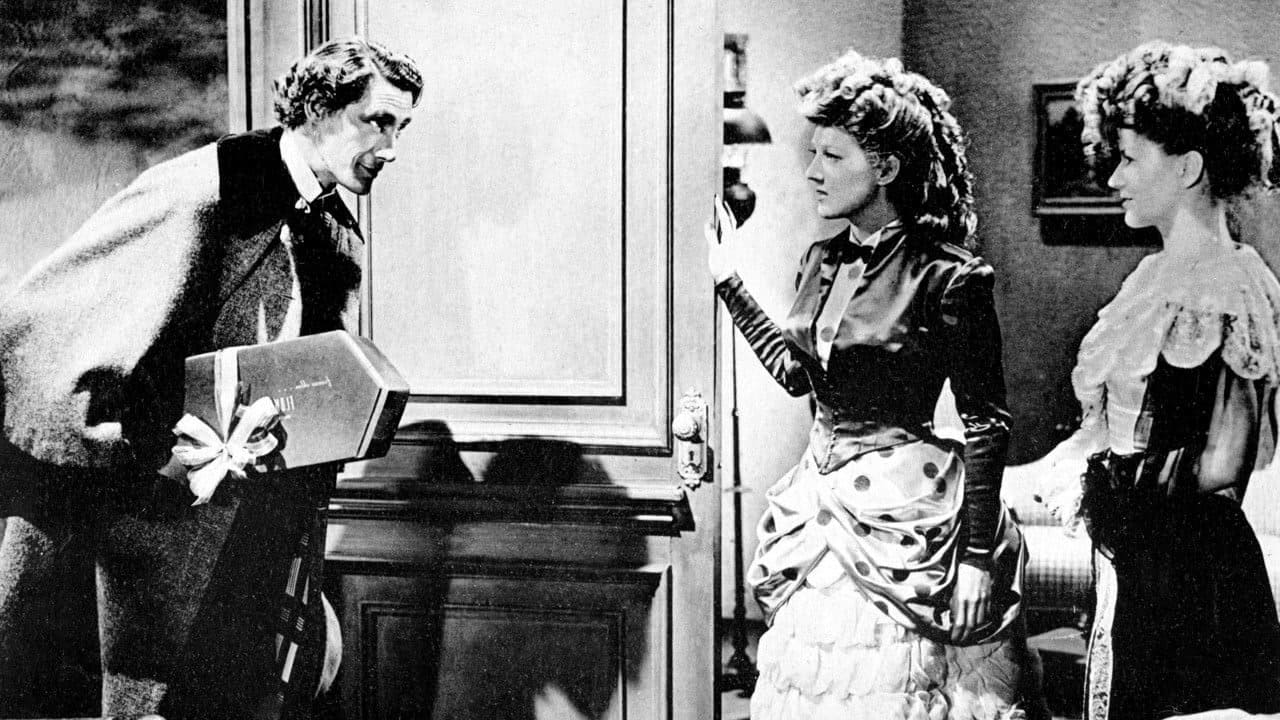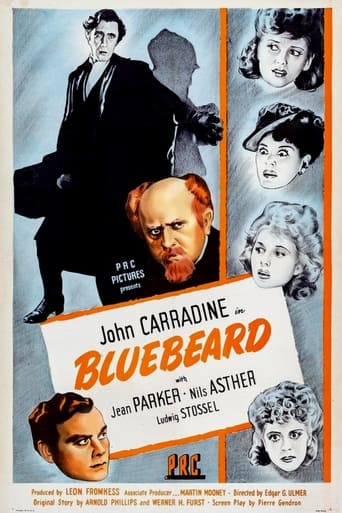

Released in 1944, "Bluebeard" stars John Carradine as a puppeteer in Paris who, apparently, kills young women on the side.This is one of the dullest 'horror' movies I have ever seen. It took me three nights to try to watch it and I still had 20 minutes to go. I fell asleep on all three attempts and don't plan on finishing it anytime soon. I always finish movies with few exceptions and this is one of those exceptions. It's just too dull to finish! The leading lady is a babe (Jean Parker), Caradine is charismatic and the puppet sequences are well done, even amazing, but these are the only positives that come to mind. This movie spends more time wrapped around the investigation of a painting, clothing for puppets, and droll dialogue than anything interesting."Bluebeard" was shot in B&W and is old as dirt, but this wouldn't matter if the story were actually entertaining. There are a lot of ancient movies that stand up to this day because they're great, like "King Kong" (1933), "Tarzan and His Mate" (1939) and "The Wizard of Oz" (1934). Needless to say, "Bluebeard" doesn't rank with them.The movie runs 72 minutes.GRADE: D
... View MoreFilm director Edgar Ulmer was, in some ways, a pre-Sam Fuller Sam Fuller. Most of his career was spent toiling for B film production companies and producers. Yet, he has a reputation, like Fuller, of producing, if not great films, films that are certainly better than they should be, given the little money spent on them. Case in point is 1944's Bluebeard (a film whose producer Leon Fromkess would later work with Fuller), made by PRC, a 'poverty row' studio. As evidence, watch the really well wrought puppet show scene, wherein an engaging opera scene is shown. This 72 minute, black and white film is filled with such moments, including a very good performance by John Carradine, an actor second to only the great Vincent Price in B film excellence in his art form.Unfortunately, the film also has many moments that truly define it as a B film, in the sense that it is a second rate film- this includes some poor acting from many of the female characters that end up being murdered by Carradine's character. There are also the sort of nonsensical things that make up films not so well thought out. Given that Bluebeard was a character from a classic 17th Century French short story about a wife killer, it makes little sense that the residents of Paris, France (where the film was set) would so self-consciously refer to the killer by that term, since his crimes connect more closely to those of Jack The Ripper (the film is set during the Victorian Era). Also, while the film is ostensibly set in Paris, a poster is put up about town that is written in English, not French.There is, as example, an excellent performance by Nils Asther, as Inspector Lefevre, best seen in the courtroom scene where models and prostitutes are brought in to see if they recognize the painting style of the Duke's painting. None do, but Asther's suavity and wit make the scene work. Also, despite being filmed entirely on sets that do not resemble Paris, and having mostly mediocre actors, Ulmer does a very good job of creating an effective German Expressionistic type mood, resembling mostly The Cabinet Of Dr. Caligari. Credit can go to unbilled cinematographer Eugen Schüfftan.But, three things, especially, set this film apart from most B films of its day (excepting the terrific Val Lewton produced films of the 1940s). The first is the puppet opera. One has to go almost a quarter century, to Ingmar Bergman's Hour Of The Wolf for a scene of similar power that features puppets. Another, as stated, is Carradine. In a sense, like Vincent Price, he is, at first blush, not an actor of seeming De Niro-like chameleon abilities. But, like Price, his eyes tell all. In a moment, he can veer from contained rage to pathos to humor, than back to a slightly less contained rage. He has a similar angularity that also makes his body seem puppet-like, which makes the depth of his face all the more effective, as it often stands in counterpoint to his body's stiffness. The third excellent element, also mentioned, is Nils Asther as Inspector Lefevre. Aside from his court scene, there is a scene where he is bantering with the two sisters tied to Morell. Asther really walks the line between improper lusting and clever roué wit. In another scene, with Lamarte, he plays his art interest even with his detective skills, and shows multiple levels in his character. In looking up the actor, it seems he had a brief career. Too bad, because he has a quality, at least in this role, that few actors exhibit: the ability to both inhabit and transcend a character.For these three reasons, Bluebeard is a film that, while not great, and, really, not even a classic B film in the sense that schlock like Robot Monster is, is still a film that cineastes should watch, and Edgar Ulmer is a film director whose canon I will definitely be exploring in the future. Join me.
... View MoreThose unfamiliar with the pleasures to be found in the demented cinematic poetry of Edgar G. Ulmer, whose most notorious film, DETOUR (1945) has fascinated cineastes the world over for decades, will find much to enjoy in his 1944 production, BLUEBEARD. Emerging from PRC (Producer's Releasing Corporation), the same poverty row studio responsible for DETOUR (as well as several other Ulmer classics) it tells the haunting story of Gaston Morrell, a Parisian artist and puppeteer (magnificently played by John Carradine) who, after painting the portraits of beautiful women, finishes the job by strangling his models to death. Morrell seems genuinely tortured by this hideous compulsion but in true noir fashion, is powerless to do anything about it. The problem becomes even more complicated when he falls in love with Lucille (Jean Parker), a beguiling young seamstress who seems fated to become Morrell's next victim. Filmed in one week on the dank and murky back lots of poverty row, BLUEBEARD is a prime example of Ulmer's peculiar genius for turning nearly nothing into something of profound and lasting beauty. Creating a brilliantly stylized Paris under such financially limiting conditions was pair pour le cours for Ulmer and his production designer (and uncredited cinematographer) Eugen Schufftan. Schufftan had worked some fifteen years earlier with Ulmer on MENSCHEN AM SONNTAG (People On Sunday) (30) and would do so again on STRANGE ILLUSION (45), CLUB HAVANA (45) and THE WIFE OF MONTE CRISTO (46) --- all for PRC. Among the many other films photographed by Schufftan are G. W. Pabst's L'ATLANTIDE (32), Marcel Carne's LE QUAI DES BRUMES (PORT OF SHADOWS) (38), Rene Clair's IT HAPPENED TOMORROW (44), Robert Rossen's THE HUSTLER (61) and LILITH (64) and Jack Garfein's SOMETHING WILD (61). Clearly it is no accident that BLUEBEARD achieves such a distinctly expressionistic look and feel; it is the product of committed artists whose work, before and after, establish them as supreme cinematic stylists. BLUEBEARD was produced by poverty row pioneer Leon Fromkess who would achieve additional notoriety in the 1960s as the producer of two of Samuel Fuller's most provocative noir films, SHOCK CORRIDOR (63) and THE NAKED KISS (64). And finally, it has often been noted that John Carradine cited BLUEBEARD as his favorite role in a long and prolific career. It is easy to understand why. He rarely, if ever, had the opportunity to be so prominently featured at the center of a film, one that would allow him to channel his obsessively melodramatic histrionics into a character that blended so perfectly with his environment. A performance as mesmerizing as the film itself.
... View MoreFailed painter turned puppeteer John Carradine (as Gaston Morrell) is secretly terrorizing 19th century Paris, as the serial killer nicknamed "Bluebeard" (since nobody knows who he is, the name is moderately appropriate). After strangling the women, Mr. Carradine dumps them into the river Seine. The reasons for Carradine's homicidal behavior are, later, explained (in a nicely performed scene); predictably, they involve his relationship with women. Carradine's Achilles' heel appears in the form of slim-waisted seamstress Jean Parker (as Lucille). Carradine has stated the title role of "Bluebeard" was his favorite performance. The film's surprisingly weak structure and glaring soundtrack are among the obvious flaws; but, there are some enjoyable and entertaining elements present. The film is directed with style, and includes some fine performances. Carradine's characterization is, obviously, most appealing. There are other players worth watching; and, director Edgar G. Ulmer must deserve great credit. Ms. Parker helps a great deal; her character's approaching spinsterhood helps make the film, and its characters, seem more authentic. Other thirtysomething actresses of the 1940s would have declined the line, "Are you disappointed after seeing me more closely?" Nils Asther (as Lefevre) is another underrated performer appearing; his Parisian inspector, with an eye for art, is outstanding. Also notable is Sonia Sorel (as Renee); she was one of Carradine's wives, and the mother of Keith and Robert. ******* Bluebeard (1944) Edgar G. Ulmer ~ John Carradine, Jean Parker, Nils Asther
... View More